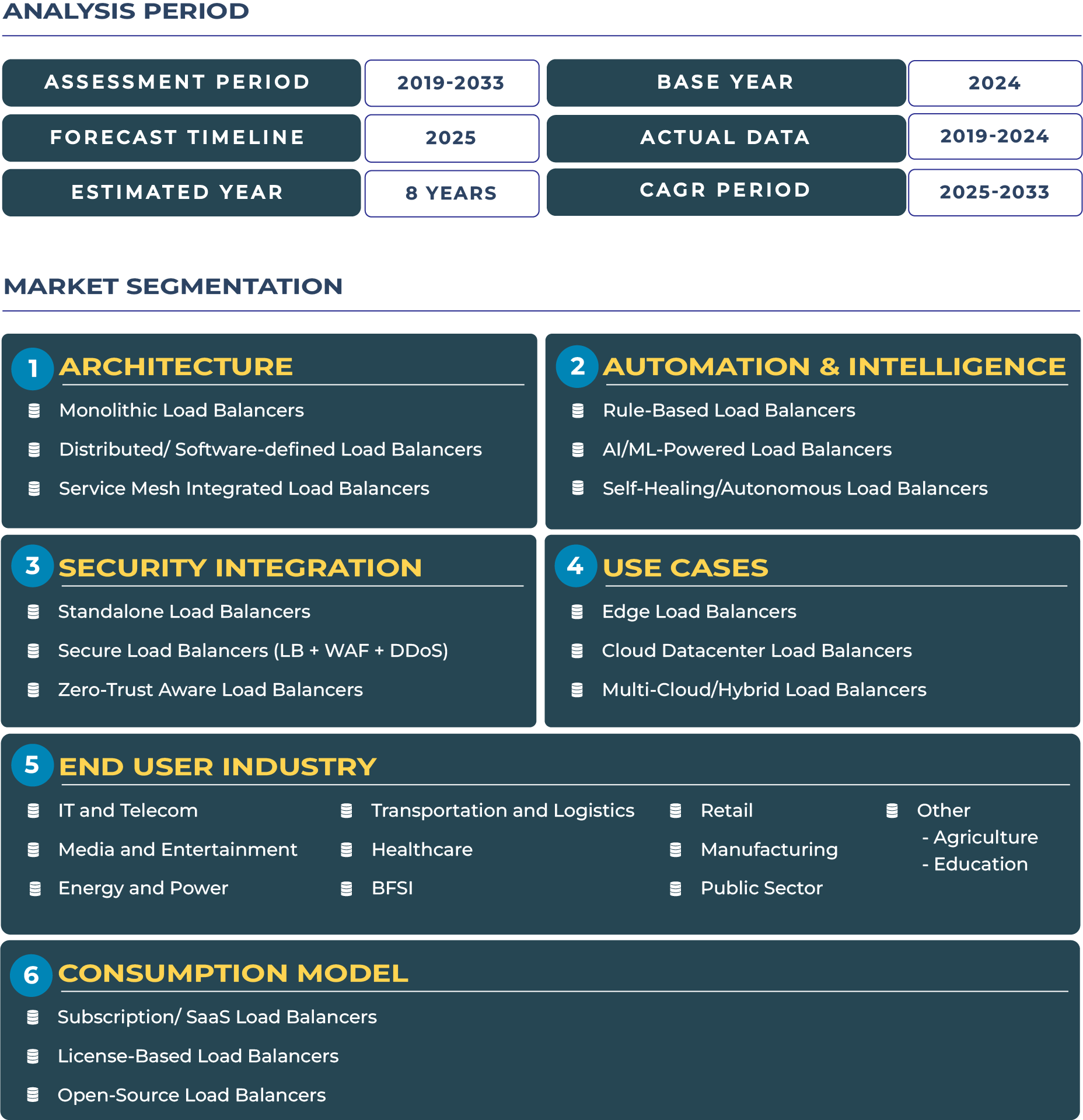Report Format:
![]()
![]() |
Pages: 110+
|
Pages: 110+
Chile Cloud Load Balancers Market Outlook: Chile Carves a Unique Niche in Cloud Load Balancers with Innovation and Green Leadership
Chile has emerged as a distinctive digital innovator in Latin America, blending its strong renewable energy base with forward-looking digital transformation policies to establish itself as a niche hub for cloud adoption. The Subsecretaría de Telecomunicaciones (SUBTEL) has played a pivotal role in strengthening the country’s international connectivity and advancing policies that encourage the digitalization of SMEs and critical industries. This alignment of sustainability and innovation is accelerating the Chile Cloud Load Balancers Market, which is projected to expand from USD 18.6 million in 2025 to USD 75.8 million by 2033, achieving a strong CAGR of 19.2% (2025–2033), according to DataCube Research.
The growing reliance on distributed/software-defined load balancers is evident across enterprises modernizing their digital ecosystems, while service mesh integrated load balancers are gaining traction among fintechs and software providers scaling cloud-native applications. By leveraging its stable business climate, policy-driven digital innovation, and abundant renewable resources, Chile is positioning cloud load balancers as foundational tools to ensure application resilience and multi-cloud interoperability.
Drivers & Restraints: Understanding the Push and Pull Factors in Chile Cloud Load Balancers Industry
The Chilean cloud load balancers ecosystem benefits from several strong drivers. The country’s stable political and macroeconomic climate fosters investor confidence, ensuring consistent growth in ICT projects. Large industries such as mining and utilities are rapidly digitalizing operations, adopting advanced load balancing to manage mission-critical applications and data workloads. Additionally, Chile’s robust international connectivity—underpinned by subsea cables linking the country with North America and Asia-Pacific—provides enterprises with reliable access to global cloud ecosystems. This connectivity is particularly critical for enabling low-latency distributed load balancing across hybrid and multi-cloud deployments.
However, challenges remain. The smaller size of the local enterprise market compared to regional giants like Brazil limits the overall addressable opportunity. Dependence on commodity cycles, particularly copper exports, makes ICT budgets vulnerable to market fluctuations. Moreover, limited hyperscaler presence compared to regional peers constrains the pace of adoption for certain advanced service mesh integrated solutions. These restraining factors underscore the need for a targeted, innovation-driven approach to unlock Chile’s cloud load balancers potential.
Trends & Opportunities: Shaping the Next Phase of Cloud Load Balancers in Chile
Several key trends are reshaping Chile cloud load balancers landscape. Industrial IoT and edge computing in the mining sector are creating demand for low-latency, high-resilience distributed load balancing solutions. The fintech sector, concentrated in Santiago, is modernizing its IT backbone with service mesh load balancers to ensure real-time processing of payments and digital banking applications. Regional data center peering, supported by international collaborations, is strengthening the multi-cloud ecosystem, reducing latency and improving redundancy.
On the opportunity side, the growing demand for industrial-grade load balancing in mining provides a clear vertical niche for premium providers. Fintech-grade load balancing solutions tailored for regulatory compliance and high transaction volumes also represent an expanding market. Furthermore, partnerships between operators and data center providers are opening opportunities for packaged cloud services that integrate connectivity with advanced load balancing features. These opportunities highlight how Chile’s green energy advantage and pro-innovation policies can amplify adoption in specific verticals.
Competitive Landscape: Local Agility and Global Entrants Defining Chile Cloud Load Balancers Sector
Chile’s cloud load balancers competitive landscape is a blend of international players and domestic agility. Global technology leaders such as F5 Networks and Citrix are actively expanding their footprint by aligning with local managed service providers. Local telecom operators like Entel and Telefónica Chile are targeting SMEs with bundled connectivity and cloud services, lowering entry barriers for advanced load balancer adoption.
A distinct strategy in the Chilean ecosystem is vertical targeting. Providers are offering premium SLAs and mission-critical load balancing solutions specifically for mining and fintech industries, recognizing their demand for high availability and low tolerance for downtime. This specialization, supported by Chile’s pro-innovation policies and digital frameworks, positions the market as a promising niche for both global and local players. The competitive differentiation lies in the ability to deliver sustainable, scalable, and sector-specific load balancing packages.







